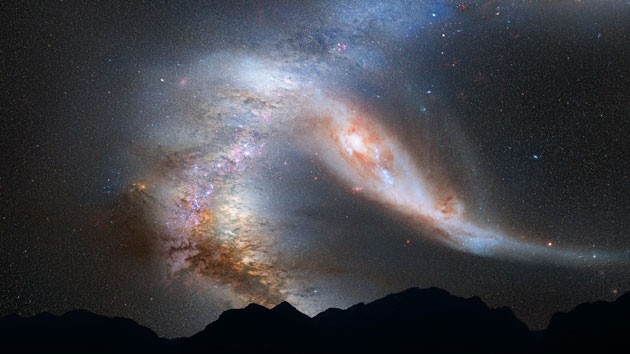The Andromeda Galaxy is a giant swirl of around a trillion stars just down the street from the Milky Way. But billions of years from now, it will collide with our home galaxy.
On a clear night away from city lights, you can just make out a long, fuzzy blob known as the Andromeda Galaxy if you look toward the constellation Andromeda.
Although it is 2.5 million light-years away, the Andromeda Galaxy, or M31, is our Milky Way’s nearest large neighbor. That makes it the most distant object regularly visible with the naked eye.
According to some estimates, the Andromeda Galaxy contains one trillion stars. It has a diameter of more than 200,000 light-years. That’s much larger than the Milky Way, which, according to more recent estimates, is 150,000 light-years across (though the exact boundary of where either of these galaxies “end” is a bit nebulous). Astronomers are still struggling to get an accurate count, but our galaxy appears to have a quarter to half the number of stars as Andromeda.

ESA/Herschel/PACS/SPIRE/J. Fritz, U. Gent; X-ray: ESA/XMM Newton/EPIC/W. Pietsch, MPE
The Andromeda Galaxy’s discovery
For thousands of years, ancient skygazers may just have pondered the nature of this hazy spot. The Andromeda Galaxy, on the other hand, was discovered in 964 A.D. by a Persian astronomer named Abd al-Rahman al-Sufi, who wrote a book about “Fixed Stars.” In it, he mentioned Andromeda and noted the location of the Large Magellanic Cloud, a much smaller satellite galaxy of our Milky Way. The Andromeda Galaxy was described as a “small cloud” in the sky.
But it wasn’t until the 1800s that astronomers realized how unique Andromeda was. That’s because, until about a century ago, scientists believed our Milky Way was the center of the universe.
For a long time, observers using telescopes to look for comets had been finding “nebulae” — a term that referred to any fuzzy night-sky object that wasn’t a comet. Spiral nebulae were those with spiral shapes, such as Andromeda. However, in 1864, an English astronomer named Sir William Huggins used a prism to separate and analyze the different colors of light from various nebulae. Huggins noticed that the light spectra of M31 was very different from some of these other nebulae.
The great galaxy debate
Other astronomers began to notice supernovae exploding in Andromeda over the next few decades. One astronomer in particular, Heber Curtis, used the known brightness of these explosions to calculate the distance to Andromeda. He estimated that this “spiral nebulae” was an unprecedented 500,000 light-years away, which would put it well outside the confines of our Milky Way.
Vesto Slipher, an astronomer at Lowell Observatory in Flagstaff, had turned the 24-inch Clark Telescope on M31 a few years before and measured it moving toward us at an astonishing rate. Meanwhile, Slipher’s measurements of more than a dozen other spiral nebulae revealed that, with the exception of three, they were all moving away from Earth.
In the famous “Great Debate” between Curtis and Harlow Shapley – the latter an ambitious young scientist, these findings were presented as some of the opening salvos. Many scientists agreed with Shapley’s long-held belief that the Milky Way was the entirety of the Universe. However, evidence appeared to suggest that Andromeda, as well as other mysterious spiral nebulae, were in fact “island universes.” It would take years to reach a conclusion to the debate.
Milkomeda: the Milky Way and Andromeda collide
We now know the Andromeda Galaxy truly is an island universe distinct from our own. But it won’t always be that way.
As Slipher’s observations first revealed, the Milky Way and Andromeda will become uncomfortably close over the next five billion years or so. The pair will exchange glancing blows, ripping stars from one another and transforming them into long, drawn-out tails.
During these encounters, the Andromeda Galaxy will loom large in our night sky as seen from Earth. However, as the two become completely entangled, they will merge into one massive group of stars. But instead of a spiral galaxy, the final object will be an elliptical. This future galaxy is known as Milkomeda by astronomers, and mergers like this happen all the time.

While it may appear that a collision between two galaxies will only lead in destruction, galaxy mergers frequently result in extreme bursts of star formation. This will also be visible from our solar system, though humans are unlikely to survive long enough to see it.
Nonetheless, the aftermath of the Milkomeda collision will leave our night sky awash with bright, new stars. So, instead of this galactic clash killing either of the galaxies, the mergers might even usher in new life.
READ MORE: These Two Galaxies Were Spotted Mid-Collision






We have a very beautiful galaxy. One of the most beautiful of all the known universe and we have the chance of living within it.